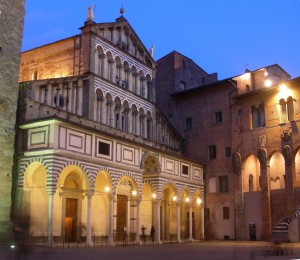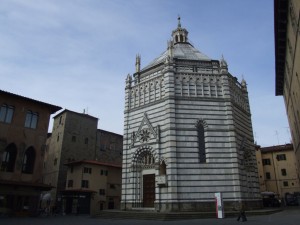Pistoia is a very nice city where you can find many interesting places to visit: www.turismopistoia.it
A few kilometres from some other famous destinations in Tuscany such as Florence, Lucca and Pisa, lies one city a little off the usual beaten paths. The city of Pistoia will be a true discovery: it is located at the foot of the Tuscan Apennines Mountains and it is about 30 kilometres north-west of Florence. Walking through the streets of Pistoia, which dates back to Roman times, you’ll find many traces of the past. Pistoia was the centre of Gallic, Ligurian and Etruscan settlements before becoming a Roman colony, founded in the 2nd century to support the Roman troops in their battle against the Ligurians.
MAIN SIGHTS
Pistoia presents a well-preserved and charming medieval city inside the old walls. You must visit:
– Piazza Duomo, which is the centre of the artistic and historic city of Pistoia and medieval buildings that form a wonderful architectural framework that surrounds it. During the summer, the “Joust of the Bear” is carried out here, and also one of the most important musical events of the summer: Pistoia Blues. The bell tower, which was converted in the thirteenth century from a tower of the Lombard era, dominates the square and three floors were added. From there, which is 67 metres high and by climbing the 200 steps, you can enjoy a panoramic view of the city. In Piazza del Duomo, you can also visit the Cathedral and the ancient Palazzo dei Vescovi (Bishops’ Palace).

– The Basilica of San Zeno; It was built before the 11th century, was rebuilt in the Romanesque-Pisan style between the 12th and 13th centuries and has a façade of alternate white and green marble. At the two ends of the cusp of the façade are two marble statues of the city’s patron saints: St. Zeno and St. James. Two loggias open in the upper tier. The marble portico is adorned with glazed terracotta by Andrea della Robbia of the early 16th century. The interior is characterised by Renaissance and Baroque interventions and other contributions made in the 16th and 19th centuries. The cathedral contains the monument to Cardinal Forteguerri, commissioned to Andrea del Verrocchio in 1473.
– Hidden in a side recess of the square stands the Baptistery, designed by Andrea Pisano and completed in the fourteenth century. Its facade is also characterised by white and green marble and it preserves a Romanesque baptismal font dating back to 1200.

– Next to the Baptistery, stands the Bishop’s Palace, which is attributed in 1091. It was the fortified residence of the Bishop of Pistoia, which became in the twelfth century, a mansion. Today it houses the Cathedral Museum. In the basement of the museum, there is a rare example of stratigraphic excavation.
– The Town Hall, built at the end of the thirteenth century, today houses the civic museum.
– The Praetorian Palace portico, decorated with fresco and tempera, completes the setting of the square.
– Palazzo Rospigliosi , which hosts the Rospigliosi and Diocesan Museums and the Lace Museum. The palazzo, built between the 16th and 17th centuries, was the residence of the Rospigliosi family, who gave the Vatican Pope Clement IX.
– The Basilica of the Madonna dell’Umiltà was built in 1495 thanks to a project by Giuliano da Sangallo and was finished by Giorgio Vasari. It has a 59 metre-high dome. In 1580s, the Rospigliosi family, one of the most important of Pistoia, started to decorate the chapels and the sacred image of the Madonna of the high altar is by Pietro Tacca, student of Giambologna.
– Pistoia offers visitors a rich itinerary in sacred buildings of great interest: from the Parish church of Sant’Andrea, with its pulpit by Giovanni Pisano, to the Romanesque policrome of San Giovanni Fuoricivitas and the seventeenth century church of Santo Spirito. Another visit should be made to the complex of the Saints Prospero and Filippo, where you can admire the superb wooden structure of the Fabroniana library.
– Near Piazza del Duomo is the historic area of Ospedale del Ceppo, with the museum of surgical instruments and anatomical room. The current complex is the result of a series of additions and restorations of the original 13th-century building. A ceramic glaze frieze executed from 1525 by Santi Buglioni decorates the loggia: it portrays the seven works of mercy, mixed with scenes of the Virtues. There are also tondoes by Giovanni della Robbia depicting the Annunciation, the Glory of the Virgin, the Visitation and the Medici coat of arms.
– The Lace Museum is dedicated to the conservation, maintenance and exhibition of textile lace materials Pistoia area has been historically famous for.
– The archaeological tour of Pistoia Underground runs to nearly 700 feet below the old town of the city. Part of it is developed under the old Ospedale del Ceppo, where you can find the ticket office, the bookshop and the entrance to the site. “Pistoia Sotterranea” is the longest underground path in Tuscany, which is also fully accessible to people with physical disabilities, including Braille panels for the blind. (Telephone +39 0573 368023 website www.irsapt.it .
